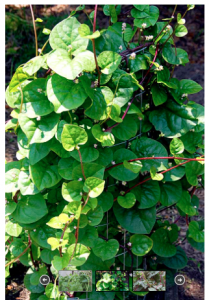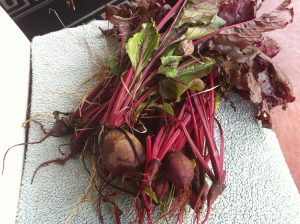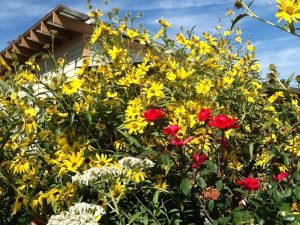What marvelous things plants are. In the hierachy of my mind, after my children and a few close friends, plants are at the top. Of course, my 300-year old Oak tree is at the top of my plant heirachy and today the bottom, is my Malabar Spinach  –doing its best to kill my favorite climbing rose as I write this. It is very enthusiastic and wants the rich ground the rose uses. This spinach is immune to any disease as far as I know and amazingly healthy food for humans; it self seeds, requires no care and is absolutely beautiful. Why do I prefer the rose? I have no idea.
–doing its best to kill my favorite climbing rose as I write this. It is very enthusiastic and wants the rich ground the rose uses. This spinach is immune to any disease as far as I know and amazingly healthy food for humans; it self seeds, requires no care and is absolutely beautiful. Why do I prefer the rose? I have no idea.
Plants are so varied and change so much in any calendar year, that any list of preferred plants shifts dramatically with each passing month. In early December I think fondly of cauliflower as I roast it for dinner. Now? Not so much. Many plants change in chemistry when attacked by a pest emitting a taste or scent to ward off enemies. Although I have planted three kinds of cauliflower, they all just sit there and let the caterpillars of the white fly eat their leaves. I don’t mean just a few holes, I mean nothing is left, nothing. So I use my battery of help for the wretched creatures because of the previously mentioned December love in the kitchen: cayenne sprinkled on the leaves, garlic spray, dish soap spray– three different organic sprays (and that is an entire post for the future). I am told to ‘pick off the caterpillars’; but, of course, they are not to be found (by me at least) until they strip a plant, turn into a white fly and proceed the the next generation. The kale and brussel sprouts are no better at defense. They are like a really bad football team.
These beautiful beets have some magic that repels disease and insects, humans have only the dimmest understanding of these plant abilities. 
It’s like fingernails on a blackboard for me to hear my dear Vegan and Vegetarian friends take pride in not eating animals, as a moral choice, and instead eat plants. Like plants have no soul, like plants are not sentient beings. Like plants are comparable to the plastic wrap they use or other disposable things in such abundance in our world. More than 150 acres of rainforests are lost every minute of every day, and 78 million acres lost every year! More than 20 percent of the Amazon rainforest is already gone, and much more is severely threatened as the destruction continues. It is estimated that the Amazon alone is vanishing at a rate of 20,000 square miles a year.http://rain-tree.com/facts.htm.
And the rainforest destruction is not to make pastures for domesticated animals to graze upon. There is plenty of pasture on the planet, much of it is not in very good shape, but it’s there. Unfortunately, our corporate culture finds feedlots a much more profitable way to raise animals. Big Agriculture wants new land to cultivate for grains, fruits, vegetables, palm oil and other oils. All this ‘food’ is more ‘moral’ somehow since it does not kill animals. Yet the expansion of ‘farmland’ does kill animals. Among a host of other ecological aberrations, this has induced what has been called ‘the sixth great extinction’ (Kolbert, 2014). Over the last 40 years we have destroyed over 50% of Earth’s vertebrae wildlife. (mammals, birds, reptilians, amphibians, and fish) (WWF, 2014).
I love animals, I think they should be nurtured and cared for and protected, especially in the wild. I just don’t think they are better than plants. I have animals. My family and friends always ask about the cow, the sheep, the dogs, the chickens. Never about spinach. Or the sunflowers now in their October bloom. This Maxmillian sunflower  is a great bully of a plant shouldering its companions aside but is covered in this photo with honey bees.
is a great bully of a plant shouldering its companions aside but is covered in this photo with honey bees.
I only wanted the animals to help improve the soil here and they have done a wonderful job. Our beautiful hill country was plowed and the topsoil ran off in the drenching rains that come up from the Gulf of Mexico. The rocky clay that remains is full of nutrients and when loosened makes a fine soil. My herbivores do what herbivores do on pasture, loosen and improve it. Think of the buffalo and our great American grasses in the 19th century sitting on top of 2 to 4 feet of rich topsoil in some places.
Perhaps this little farm is more like a puzzle; a place where hierarchy is meaningless since every piece, however small is necessary. My 300 year old Live Oak told me to buy this place many years ago and has provided unlimited mental energy and emotional support to me; but even this grand old tree needs the living soil with its microbes and tiny, even invisible creatures that make life possible.